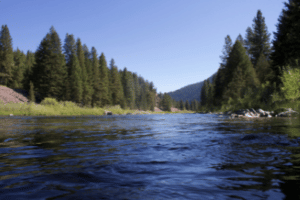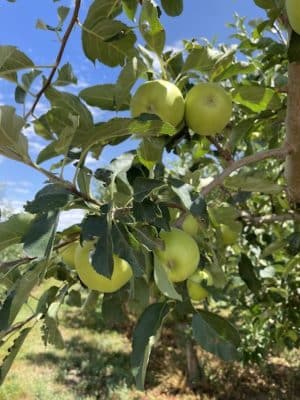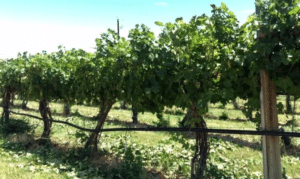
Without rain and an adequate water supply, food is not grown and the competition for water increases. Agriculture uses 50 to 80% of the western U.S. water supplies. When urban sprawl starts to creep into rural areas, competing for water, conflict emerges. Water is a precious commodity. Will it be food on the table or flowers in the yard? How we manage water will determine our future food supply. Will water be the ultimate food fight?
Water Rights Are a Reality
The right to water use may be more a headline than reality depending on where you live. Living in Kentucky, drought does occur but not at the level seen in the Western U.S. Irrigation for crops is typically available due to availability of natural water sources while households’ lawn irrigation or watering is restricted only in the driest of times.

Apple trees at Peachfork
However, west of the Mississippi River, it’s not the same. During the past few summers during my Colorado reprieve from the Kentucky humidity, I’ve come to understand what water rights mean to agriculture production. Let’s talk about Colorado River! For the casual observer, the river may seem to be the source of recreational activity and the recipient of mountain snow melts. But the Colorado River is so much more. It’s the water source for seven states within the United States and two states in northern Mexico.
Nearly 40 million Americans rely on the Colorado River system for their existence, from drinking water to livelihoods ranging from farming to recreation;1 a fact that hasn’t been ignored in Colorado since 1879. Colorado was the first state to pass legislation regarding water usage and still provides the foundation for the current water distribution system.
Peach Perfect Palisades
If you live in Colorado or have familiarity with its summertime produce, the term “Palisades Peaches” is well known. Why? Thanks to the water distribution system and guidance put in place over 140 years ago in the state, Palisades (along the I-70 corridor near Grand Junction) is known as the “land of Canaan” among the steep cliffs or palisades bordering the city. The water canals from the Colorado River are the source of irrigation for agricultural production. However, orchard growers do not take the availability of water for granted as unlimited access is not an option. The days and hours for crop irrigation and the quantity of water usage are coordinated by neighboring producers and routinely monitored by the county irrigation board. Producers understand the critical status of the water supply and continue to work on sustainable practices in conserving water.

Trellis water system at Peachfork
PeachFork, a fruit orchard and winery owned by Kentucky native (and my husband’s childhood friend) Phil Patton and his wife, Susan, a Palisades’ native, is living proof of such interventions. Using their engineering backgrounds, the Pattons have replaced most of their original flood irrigation (trenches along the fruit trees) with sprinkler irrigation especially within the vineyard trellis system (see photo). This reduces water usage by 75%. These irrigation systems along with sophisticated engineering systems to control the water flow, sediment and timing have reduced their water usage.
Additionally, throughout the area, the installation of a concrete liner in the original dirt canals have reduced water loss, another way to conserve water. However, for landowners, water quantity is just one issue. Water usage rights are another, Patton explained during a recent visit. In some areas, the land can be irrigated on one side of the canal but not the other … a defining restriction to food production.
The Agricultural Dependency

Peach trees at Peachfork
Food production is vital to our existence … and so is water. When we look at the use of water for agricultural production, the discussion (and sometimes, legal action) centers on who has the right to water. Efficient irrigation systems and water management practices are necessary to help maintain farm profitability in an era of increasingly limited and more costly water supplies.
Almost 75% of all irrigated farmland is in the 17 most western states, but these irrigated agricultural areas provide approximately half of U.S. crop sales. Vegetable crops and fruit orchards account for 16% of irrigated land use, while soybean and corn production account for 14 and 25%, respectively.2 Recent rainfalls in some parts of the country have improved drought-like conditions but the Western U.S. is still suffering.3 We do not have control over rain, but we can control our water usage.
Water — Save or Spar?
As neighborhoods develop on arid land, the competition for water use will continue. The access to water is essential for all. In the U.S., the access to fresh water should not be taken for granted as more than one billion people in the world do not have the same access.4 Water conservation like food waste requires commitment by all. What efforts do you make to save water?
Food production restrictions are often pitted against our own desire for unrestricted use. Do we value manicured lawns and golf courses over access to domestically grown produce or crops? The decision is ultimately in our hands. Regardless of where we live, water is a precious commodity. How we regulate it and use it, will determine the future of the food on our table.
References
1. “Reclamation: Managing Water in the West,” Colorado River Basin Water Supply and Demand Study Executive Summary, U.S. Department of the Interior, Bureau of Reclamation, December 2012.
2. “Irrigation & Water Use,” USDA Economic Research Service, May 06, 2022.
3. “National Drought Summary for July 26, 2022,” U.S. Drought Monitor.
4. Sustainable Development Goal 12: Ensure sustainable consumption and production patterns, United Nations.
